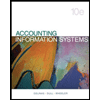
ACP AUDITING - RISK BASED APPROACH
10th Edition
ISBN: 9780357195079
Author: JOHNSTONE
Publisher: CENGAGE C
expand_more
expand_more
format_list_bulleted
Textbook Question
Chapter 6, Problem 54RSCQ
Indicate how the auditor could use substantive analytical procedures in resting the following accounts:
a. Interest expense related to bonds outstanding.
b. Natural gas expense for a public utility company.
c. Supplies expense for a factory.
d. Cost of goods sold for a fast-food franchisor (e.g., Wendy’s or McDonald’s). Note that cost of goods sold tends to average about 35% of sales in fast-food franchises.
e. Salary expense for an office (region) of a professional services firm.
Expert Solution & Answer
Want to see the full answer?
Check out a sample textbook solution
Students have asked these similar questions
Provide correct answer general accounting question
help me to solve this questions
calculate the gross margin ratio.
Chapter 6 Solutions
ACP AUDITING - RISK BASED APPROACH
Ch. 6 - Prob. 1TFQCh. 6 - Prob. 2TFQCh. 6 - Prob. 3TFQCh. 6 - Prob. 4TFQCh. 6 - Prob. 5TFQCh. 6 - Prob. 6TFQCh. 6 - Prob. 7TFQCh. 6 - Prob. 8TFQCh. 6 - Prob. 9TFQCh. 6 - Prob. 10TFQ
Ch. 6 - Prob. 11TFQCh. 6 - Prob. 12TFQCh. 6 - Prob. 13TFQCh. 6 - Prob. 14TFQCh. 6 - Prob. 15TFQCh. 6 - Prob. 16TFQCh. 6 - Prob. 17TFQCh. 6 - Prob. 18TFQCh. 6 - Prob. 19TFQCh. 6 - Prob. 20TFQCh. 6 - Prob. 21MCQCh. 6 - Prob. 22MCQCh. 6 - Prob. 23MCQCh. 6 - Prob. 24MCQCh. 6 - Prob. 25MCQCh. 6 - Prob. 26MCQCh. 6 - Prob. 27MCQCh. 6 - Prob. 28MCQCh. 6 - Prob. 29MCQCh. 6 - Prob. 30MCQCh. 6 - Prob. 31MCQCh. 6 - Prob. 32MCQCh. 6 - Prob. 33MCQCh. 6 - Prob. 34MCQCh. 6 - Prob. 35MCQCh. 6 - Prob. 36MCQCh. 6 - Prob. 37MCQCh. 6 - Prob. 38MCQCh. 6 - Prob. 39MCQCh. 6 - Prob. 40MCQCh. 6 - Prob. 41RSCQCh. 6 - Prob. 42RSCQCh. 6 - Prob. 43RSCQCh. 6 - Prob. 44RSCQCh. 6 - Refer to Exhibit 6.2 and describe the differences...Ch. 6 - Prob. 46RSCQCh. 6 - Prob. 48RSCQCh. 6 - Prob. 49RSCQCh. 6 - Prob. 50RSCQCh. 6 - Prob. 51RSCQCh. 6 - Prob. 52RSCQCh. 6 - Prob. 53RSCQCh. 6 - Indicate how the auditor could use substantive...Ch. 6 - Prob. 55RSCQCh. 6 - Prob. 56RSCQCh. 6 - Prob. 57RSCQCh. 6 - Prob. 58RSCQCh. 6 - Prob. 59RSCQCh. 6 - Prob. 60RSCQCh. 6 - Prob. 61RSCQCh. 6 - Prob. 62RSCQCh. 6 - Prob. 63RSCQCh. 6 - Prob. 64RSCQCh. 6 - Prob. 65RSCQCh. 6 - Prob. 66RSCQCh. 6 - Prob. 67RSCQCh. 6 - Prob. 68RSCQCh. 6 - Prob. 69FFCh. 6 - Prob. 70FFCh. 6 - Prob. 71FFCh. 6 - Prob. 72FFCh. 6 - MINISCRIBE (LO 1, 2) As reported in the Wall...
Knowledge Booster
Learn more about
Need a deep-dive on the concept behind this application? Look no further. Learn more about this topic, accounting and related others by exploring similar questions and additional content below.Similar questions
arrow_back_ios
SEE MORE QUESTIONS
arrow_forward_ios
Recommended textbooks for you
 Auditing: A Risk Based-Approach (MindTap Course L...AccountingISBN:9781337619455Author:Karla M Johnstone, Audrey A. Gramling, Larry E. RittenbergPublisher:Cengage Learning
Auditing: A Risk Based-Approach (MindTap Course L...AccountingISBN:9781337619455Author:Karla M Johnstone, Audrey A. Gramling, Larry E. RittenbergPublisher:Cengage Learning Pkg Acc Infor Systems MS VISIO CDFinanceISBN:9781133935940Author:Ulric J. GelinasPublisher:CENGAGE L
Pkg Acc Infor Systems MS VISIO CDFinanceISBN:9781133935940Author:Ulric J. GelinasPublisher:CENGAGE L Auditing: A Risk Based-Approach to Conducting a Q...AccountingISBN:9781305080577Author:Karla M Johnstone, Audrey A. Gramling, Larry E. RittenbergPublisher:South-Western College Pub
Auditing: A Risk Based-Approach to Conducting a Q...AccountingISBN:9781305080577Author:Karla M Johnstone, Audrey A. Gramling, Larry E. RittenbergPublisher:South-Western College Pub College Accounting, Chapters 1-27AccountingISBN:9781337794756Author:HEINTZ, James A.Publisher:Cengage Learning,
College Accounting, Chapters 1-27AccountingISBN:9781337794756Author:HEINTZ, James A.Publisher:Cengage Learning,

Auditing: A Risk Based-Approach (MindTap Course L...
Accounting
ISBN:9781337619455
Author:Karla M Johnstone, Audrey A. Gramling, Larry E. Rittenberg
Publisher:Cengage Learning


Pkg Acc Infor Systems MS VISIO CD
Finance
ISBN:9781133935940
Author:Ulric J. Gelinas
Publisher:CENGAGE L

Auditing: A Risk Based-Approach to Conducting a Q...
Accounting
ISBN:9781305080577
Author:Karla M Johnstone, Audrey A. Gramling, Larry E. Rittenberg
Publisher:South-Western College Pub

College Accounting, Chapters 1-27
Accounting
ISBN:9781337794756
Author:HEINTZ, James A.
Publisher:Cengage Learning,
Accounting Basics Explained Through a Story; Author: Leila Gharani;https://www.youtube.com/watch?v=VYNTBWBqncU;License: Standard Youtube License